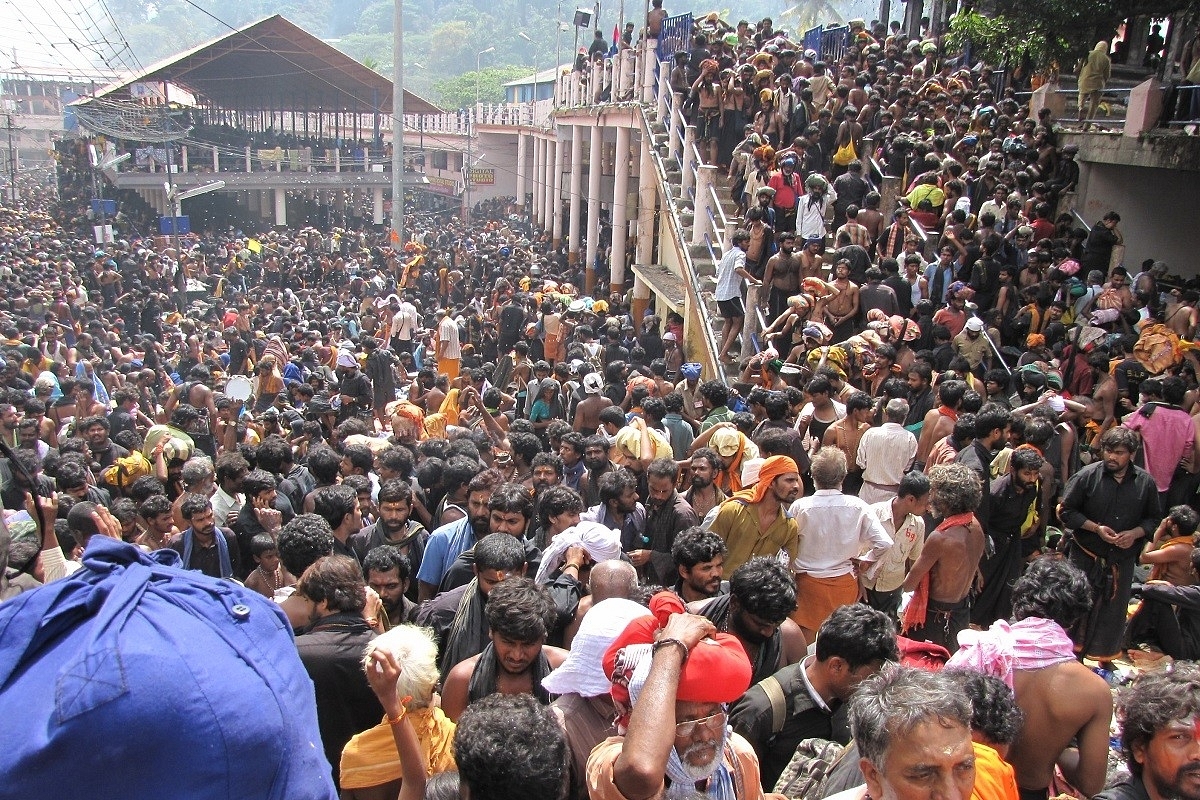Commentary
India's Pilgrimage Paradox: Booming Infrastructure Meets Deteriorating Temple Experiences

Devotees rush at the Sabarimala temple during pilgrimage season (By Avsnarayan/Wikimedia Commons)
India's break-neck infrastructure development spree and increasing levels of prosperity have allowed more and more yatris to go on their favourite pilgrimages.
Nobody expects better facilities or improved temple going experiences at any of the ancient, large temple complexes in India. Maladministration of heritage spaces is almost always a given but we may be entering an era of worsening temple experience for the average devotee.
On 12 December, a video of an Ayyappa devotee having blood on his nose and face went viral. He was allegedly assaulted by security staff after a group of devotees returning from Sabarimala reportedly protested against the long time taken for darshan at the Sri Ranganathaswamy Temple in Srirangam. The temple is under the control of the Hindu Religious and Charitable Endowments (HRCE) department.
The CPI(M) government in Kerala too is facing criticism for long wait times for darshan at Sabarimala. News reports have stated that devotees have waited for as long as 14 hours. A girl died on Saturday (9 December) while waiting in the queue.
The last thing that should happen to a devotee going to have darshan of our deities is to lose his or her life due to a long queue.
There have been stampedes due to crowding at temples. Some of the incidents that come to mind are the ones at the Vaishno Devi temple in Jammu and Kashmir on 1 January 2022 in which 12 people lost their lives and another incident at the Khatu Shyam temple in August that year, which killed 3 people.
Prime Minister Narendra Modi himself has spearheaded projects such as the Kedarnath and Kashi corridor projects where a lot of old clutter has been removed and an attempt has been made to improve the temple going experience. The new corridors have in turn led to more pilgrims.
The upcoming Shri Rama temple at Ayodhya Ramajanmabhumi is also going to see footfalls in tens of lakhs - pilgrims who will likely also visit many other teertha kshetras.
The coming years are going to see so much more pilgrimage activity - more Vande Bharat trains, air connectivity and ever improving roads are going to bring crores of new people to India's temples.
While the new Ayodhya temple has been built to take lakhs of pilgrims, many of the millennia old temple sites in South India are not. Built in eras before large scale transport, these temples may be large but will need upgrades to help aged visitors and pilgrims with children.
The queuing process during festive seasons and holidays has more or less destroyed the sanctity of a pilgrims darshan of the main deities. Long wait times in cage like structures, the jostling right at the sanctum sanctorum, poor lighting and ventilation - the temple administration almost never has the pilgrim's darshan experience in mind. Clean toilets are very rare.
The Venkateshwara Swamy temple at Tirupati is a honorable exception and has a relatively better temple going experience. But this is a result of relentless investment in virtual queue systems that allow pilgrims scheduled darshans, decluttering the heritage space and a maniacal daily effort to clean the place.
No other large temple complex in Tamil Nadu, for instance, has made such investments. If push comes to shove, a HRCE minister will decide to build a new 'shopping complex' for pilgrims - there is no evidence yet to say that limits of imagination of such ministers extend beyond 'shopping complexes'.
Heritage travel in India urgently needs new ideas and massive investments, every major temple town needs projects like the Kashi corridor covering larger old city areas. Temple administrators must find ways to engage and comfort the crores who will come to their temples - so far all that we have seen are more cages for queues and longer wait times.
The well intentioned devotees who are fighting to free temples from the maladministration of indifferent government staff must also make temple experience a part of their agenda. A pilgrim must feel like coming back for a second visit - and if she doesn't we may be doing disservice to the tradition of teertha yatras in this country.
Support Swarajya's 50 Ground Reports Project & Sponsor A Story
Every general election Swarajya does a 50 ground reports project.
Aimed only at serious readers and those who appreciate the nuances of political undercurrents, the project provides a sense of India's electoral landscape. As you know, these reports are produced after considerable investment of travel, time and effort on the ground.
This time too we've kicked off the project in style and have covered over 30 constituencies already. If you're someone who appreciates such work and have enjoyed our coverage please consider sponsoring a ground report for just Rs 2999 to Rs 19,999 - it goes a long way in helping us produce more quality reportage.
You can also back this project by becoming a subscriber for as little as Rs 999 - so do click on this links and choose a plan that suits you and back us.
Click below to contribute.
Latest